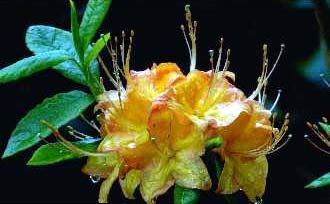Fungi are the bane of every gardener. But they do not have to disrupt the tranquility of your garden. All you need is vigilance and a good knowledge of your opponent.
Roses are one of nature's delights. No other single type of flower has summoned forth as large a group of fanatically loyal and enthusiastic gardeners. Yet the one thing that discourages some people from growing roses is the reputation these plants have for being susceptible to disease, and therefore requiring constant spraying and attention. It is not possible, or even desirable, to completely banish disease from the garden.
What Are Fungi?
A fungus is actually a simple plant. Though fungi are quite small, they are multicellular, not single-celled organisms. Fungi lack chlorophyll; thus, unlike other plants, they cannot manufacture food using the energy in sunlight. In order to get the food they need to survive, fungi live as parasites on plants that have chlorophyll. Fungi are rather delicate and need special conditions to thrive. Most of all, they need plenty of moisture (since, unlike other plants, they don't have roots to draw water from the soil). They also need warmth and still air. They don't need sunlight; in fact, sunlight hurts them by drying their environment. Once you know the conditions fungi need to thrive, it's easier to create conditions that discourage them.
Fungal Diseases of Roses
There are several different fungi that can afflict roses. The most common are black spot, powdery mildew, and rust. Black spot is a fungal disease that often develops during very warm, humid weather. The first symptom is the appearance of tiny black splotches on the leaves. Eventually the affected areas of the leaves turn yellow and drop off. The spores that form at each black spot are easily transmitted from one plant to the next.
Powdery mildew also gets its start during warm, humid spells, especially when roses get too little sun. Canes, young leaves, and buds become covered with a white or powdery gray coating. Sulfur sprays are often effective against powdery mildew, but must be applied when temperatures are 85� F or less.
Rust begins with small yellow or orange pustules on the undersides of leaves. The upper sides of the leaves later turn yellow, and eventually drop off. Rust most often gets started in spring when heavy rains combine with warm days and cool evenings to make perfect conditions for fungal growth. The rust spores stay on dead leaves, and can reinfect plants next season. So clean up dead foliage immediately.
Preventing Disease
Healthy plants are less susceptible to disease. There are 2 basic things you can do to prevent fungal diseases in roses. First, choose disease-resistant rose varieties. Make sure they get plenty of sun, adequate water, moderate air circulation, and regular feeding. Allow adequate space between plants. Consider planting different kinds of roses together, or scattering specimens or small groups throughout the garden. Disease can spread rapidly through a formal rose garden where a large number of the same kinds of roses are too near each other. Secondly, do everything you can to discourage fungi from getting started. Avoid overhead watering, as lingering moisture on leaves and blossoms may lead to mildew or black spot. Remove shriveled, dead, or diseased foliage promptly.
What About Fungicides?
There are a wide variety of fungicides on the market. Some are copper- or sulfur-based compounds that do relatively little harm to the environment. But most are highly toxic organic chemicals. Not only is it dangerous to introduce these long-lasting poisons to the garden soil, it's also expensive. And in the long run, the effectiveness of even the latest "systemic" fungicides (fungicides that are absorbed by the rose's root system) is questionable. Repeated use of these chemicals encourages the growth of new, more damaging strains of fungus that are immune to poisoning.
There may be occasions when weather and other circumstances encourage an outbreak of fungal disease. Don't panic at the first sign of fungal disease. Even in a well-tended garden there will be mild fungus infestations from time to time. If you follow these recommendations, chances are that the infestation will pass.
STEPS FOR SUCCESSFUL ROSES
1)
Planting roses in rich, fertile soil and in a location with full sun and good air circulation is essential.
2)
Regular pruning is important in maintaining health. Here, frost damaged canes are being removed.
3)
It’s also important to prune away all dead or diseased stems and foliage.
4)
Use shallow cultivation techniques to aerate the soil. Promptly remove fallen leaves.
5)
Interplanting with garlic or lavender helps reduce the chance of fungal diseases.
Unless you are planning to harvest rosehips, remove blossoms as they fade.
TIPS
Keeping the rose garden clean is one of the best things you can do to prevent fungal diseases. Remove dead or diseased foliage promptly, especially at the end of the season.
Ask a nursery or local rose expert which varieties of disease-resistant roses have done well in your area. The climate and soil of your particular area will favor certain varieties. Because of this, roses especially suited to your conditions are less likely to be attacked by fungus.


